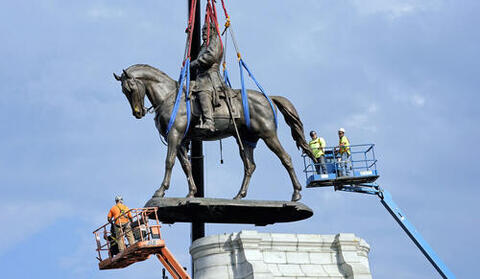Memory and memorials: Yale scholar’s work influences removal of Lee statue

By Mike Cummings
Yale historian David Blight visited Richmond, Virginia, often in the late 1990s while researching the Civil War’s effect on American memory. When not sifting through archives, he’d jog along the city’s famed Monument Avenue, named for the five grandiose memorials to Confederate leaders that adorned the tree-lined boulevard and grassy mall.
At the time, Blight couldn’t imagine that those monuments would ever come down.
“It was unthinkable,” he said. “This was the most important shrine to the Confederacy right in the heart of Richmond, the former Confederate capital.”
More than 20 years later, Blight had a role in the legal battle that paved the way to removing the last and most prominent of the avenue’s Confederate monuments: a towering equestrian statue of rebel general and slaveowner Robert E. Lee.
Virginia Gov. Ralph Northam’s legal team invited Blight, Sterling Professor of History at Yale and Pulitzer-Prize winning author of “Frederick Douglass: Prophet of Freedom,” and his colleague Gaines Foster of Louisiana State University, to submit an amicus brief to the state’s supreme court supporting the governor’s decision to remove the monument to Lee, a man who declined Abraham Lincoln’s offer to appoint him major general, resigned his commission in the U.S. Army, and led the Army of Northern Virginia in many of the Civil War’s bloodiest battles.
The historians helped the governor’s lawyers draft the brief, which puts the monument’s origins in historical context, relying on the work of Blight, Foster, and several of their colleagues to demonstrate that the statue was erected in 1890 to celebrate the defeat of Reconstruction and the redemption of white supremacy in the South. The brief augmented testimony delivered in a court hearing by historians Edward Ayers of the University of Richmond and Kevin Gaines of the University of Virginia.
In a unanimous Sept. 2 ruling affirming the governor’s decision, the court cited the historians’ arguments that the monument honored the “Lost Cause” of the Confederacy — the myth that the rebel states had noble aims not centered on preserving slavery — and symbolized racial injustice.
See below for a link to the full article and links to download the amicus brief as well as the opinion by Justice Bernard Goodwyn of the Circuit Court of Richmond City, September 2, 2021.
